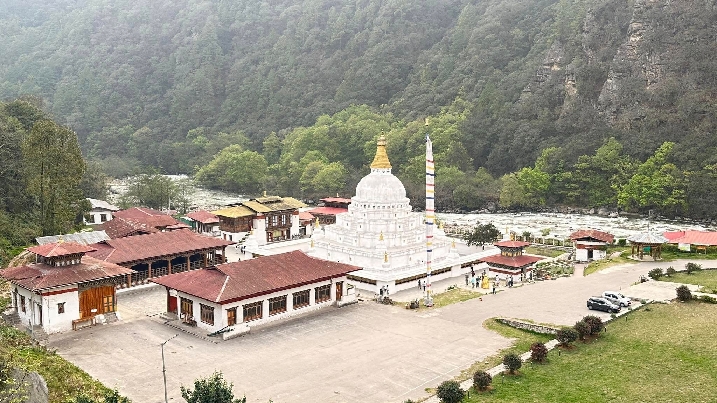According to local lore, the land where Choeten Kora now stands was once plagued by a malevolent spirit, causing great suffering to the people of Trashi Yangtse. Seeking liberation, the community turned to Lama Ngawang Loday, the Chief Abbot of Rigsum Gompa. In response, Lama Loday envisioned the construction of a stupa modeled after the sacred Jarung Khashor (Boudhanath Stupa) in Nepal, a monument known for its spiritual potency.
The construction of Choeten Kora began in 1740 and took twelve years to complete, with the heartfelt support and voluntary labor of devotees from Trashi Yangtse, Trashigang, Kurtoe, Zhonggar, and Mön Tawang. In time, the completed stupa was consecrated by His Holiness Je Yonten Thaye, who invoked the blessings of Dechhog Pawo Chigpa, purifying the site and subduing all harmful influences.
One of the most profound legends associated with Choeten Kora tells of a 16-year-old girl from Dakpa Tsosum in Mon Tawang, believed to be an emanation of the wisdom dakini Yeshe Tsogyal. On the 15th day of the first lunar month, she offered herself in sacrifice by entering the dome of the stupa, dissolving into a body of rainbow light. Her act of ultimate devotion sanctified Choeten Kora forever, and continues to inspire generations of practitioners.
The architecture of Choeten Kora is filled with spiritual symbolism. Four large eyes, painted on each side of the stupa, represent the all-seeing wisdom of the Buddhas. One eye, directed toward the cliff, bears a wrathful expression—serving as a reminder of the stupa’s protective function and its role in guarding the sacred landscape.
The original stone pinnacle (sertog) of the stupa was later replaced by a gilded structure, under the guidance of Lama Shacha Gyalpo, the sixth abbot of Rigsum Goenpa. Legend holds that after fervent prayers, the massive stone pinnacle descended to the ground through the miraculous intervention of khandromas (dakinis). This sacred stone still rests beside the stupa, and devotees believe that circumambulating it holds equal merit to circling the stupa itself.
Each year, Choeten Kora becomes the focal point of two spiritually significant festivals:
• Dakpa Kora (15th day of the 1st lunar month): Commemorating the selfless sacrifice of the young dakini, this pilgrimage draws devotees from Arunachal Pradesh, India, particularly the Dakpa community.
• Drukpa Kora (30th day of the 1st lunar month): A time for Bhutanese pilgrims from Trashi Yangtse, Trashigang, Kurtoe, and surrounding regions to come together in a collective display of devotion and prayer.
These events are more than cultural celebrations—they are powerful acts of spiritual renewal, where vows are reaffirmed, karmic obscurations purified, and blessings received through heartfelt circumambulations.
To this day, Choeten Kora stands as a sacred sanctuary where the aspirations of past generations meet the devotion of the present. Every stone, every circumambulation, and every whispered prayer contributes to the living heritage of the site. It is not merely a destination—it is a profound opportunity to awaken the heart, accumulate merit, and receive the blessings of the enlightened ones.








